APES UNIT 8 TEST REVIEW
1/93
Earn XP
Description and Tags
this includes everything from all the class slides
Name | Mastery | Learn | Test | Matching | Spaced |
|---|
No study sessions yet.
94 Terms
Bhopal Gas Tragedy
December 3, 1984
Bhopal, Madhya Pradesh, India
involved the Union Carbide Corporation, owned the pesticide plant, and Gov of India.
residents and employees were affected in the clean up and aftermath of event
resulted from combination of unsafe, equipment malfunctions, and poor emergency preparedness
long term contamination of soil and water creating various health issues: respiratory problems, neurological disorders, and birth defects
releasing more than 40 tons of methyl isocyanate gas from a pesticide plant.
More than 3,800 people immediately died, causing premature death for thousands
Baia Mare Cyanide Spill(2000)
Jan. 30, 2000 ~ 2010
Baia Mare Municipality and Brett Montgomery, owns %50 of the mining company
Baia Mare, Romania, downstreams of the Danube & Tisza River
6cow deaths, 3900 km of dead river and 700 km at risk, Water 100 times the legal limit of cyanide, 80-100% of fish died
Dam busted after being built due to a unusual meteorological conditions, Gold mine released 100,000 cubic meters of waste contaminated with cyanide
was a goldmine that recently implemented cyanide, was used to leach out more ore, then put into dammed ponds
Brett Montgomery had paid off people to keep silent of previous leakages
Unusual high temps causing frozen water burst the dam
The Minamata Disease
1932-1968
occured in Minamata Bay, Japan.
caused by a local petrochemical and plastics maker named Chisso Corporation, affected the local residents
27 tons of Mercury was dumped into Minamata Bay
methylmercury (MeHg) poisoning in humans who ingested fish and shellfish contaminated by waste water from a chemical plant.
There were 2282 confirmed cases.
ataxia, numbness in the hands and feet, general muscle weakness, loss of peripheral vision, and damage to hearing and speech.
Love Canal
Between 1942 and 1953
The Hooker Electrochemical Company
Niagara Falls
used the abandoned Love Canal to dispose 21,000 tons of hazardous chemicals
triggered by massive amounts of rainfall
Inc in miscarriages, stillbirths, crib deaths, nervous breakdowns, hyperactivity, epilepsy and urinary tract disorders
migration and contamination of soil, groundwater and basement air of nearby homes
Dioxin Release
Seveso, Italy
July 10th, 1976
Hoffmann-La Roche, the company that ran the ICMESA
Valve boke at the Chemical Plant in Seveso, lead to release of a chemical cloud containing highly toxic dioxin TCDD
chemical reactor overheating, contained a mixture of trichlorophenol and other chemicals that reacted together and produced an unexpected increase in temperature, leading to a valve to break
killed 3,000 animals within days, inflamed skin with lesions, and destroyed all locally grown fruit and vegetables
Centralia, PA
we don’t know who was involved
Air and Soil pollution, Respiratory issues, Vegetation slowly burns, Carbon Monoxide emission
May 27th of 1962 and still continues to burn till this day
After the mines were abandoned, they were filled with trash and rodents. The city burnt out all the waste. bad decision, fires grew out of control and cause carbon monoxide vapors to leak out in the air
fire spread to underlying coal seams, igniting them and leading to an ongoing underground fire
Cuyahoga River Fire
June 22, 1969
industries along the River related to manufacturing and steel production, contribute the discharge of industrial waste and chemical, Sewage from cities and towns contributed to its pollution
Clean Water Act of 1972 and Government agencies at the local, state, and federal levels became involved in efforts to clean up the river
occurred in Cleveland, Ohio
Railroad bridges near Republic Steel trapped debris in the river, Oil on the water added to its flammability. A flare tossed from an overpassing train likely provided the spark that ignited the debris. lasted for less than a half hour and resulted in minor damage
degraded aquatic habitats. Vegetation and soil quality were also harmed by the fire. water quality to be degraded. increased chemical exposure to nearby communities
Gold King Mine
August 5, 2015
Denver, Colorado
Contractors accidentally destroyed the plug holding water trapped inside the mine, caused overflow of the pond, spilling three million gallons of mine waste water including heavy metals such as cadmium and lead, and other toxic elements
affected several downstream communities and ecosystems along the Animas river in Colorado and New Mexico. It released toxic waste containing heavy metal lead and arsenic disturbing ph water levels and killing aquatic life
EPA cleaning team tried to install a pipe to divert water but failed
Gruinard Island
1942-1943 at the north west coast of Scotland
Anthrax bombs were tested
island was used to test/create biological weapons
Great Britain and United States were afraid of Germans using biological weapons in World War 2, so they created their own which is now known as Gruinard Island
Caused 79 cases of anthrax, including 68 human deaths. harmed the animals living in the environment there as well.
Great Pacific Garbage Patch
Fishing industries and Industrial Asian countries
in the North Pacific Gyre
discovered 1997 when Captain Charles Moores was sailing between Hawaii and California, noticing the plastic build up
The currents between East Asia and the West Coast of North America picked up lots of trash and debris
polluted with an array of plastics and microplastics
microplastics bioaccumulate in the organs of the food we consume from the ocean
Flint Water Crisis
Flint Michigan, USA
April 2014 and continued over several years
The decision to switch the water source and the failure to apply corrosion inhibitors were primarily due to financial constraints and mismanagement by city and state officials
widespread lead contamination, causing developmental issues. There were also outbreaks of Legionnaires' disease that led to several deaths
Toxicity Response
Acute: immediate/rapid harmful reaction to an exposure
Chronic: permanent/long lasting consequence from exposure to a single dose or to repeated sub-lethal doses of harmful substances.
Toxic Agents
Mutagens: chemicals or ionizing radiation that cause or increase the frequency of random mutations in DNA molecules
Teratogens: chemicals that cause harm or birth defects to a fetus or embryo. (Phocomelia/thalidomide)
Carcinogens: chemicals or ionizing radiation that cause or promote cancer
Estimating Toxicity
Clear wells= high toxicity (all bacteria dead)
Blue wells = low toxicity or nontoxic
LD-50
Or median lethal dose
amount in one dose that kills 50% of the animals in a test population within a 14-day period.
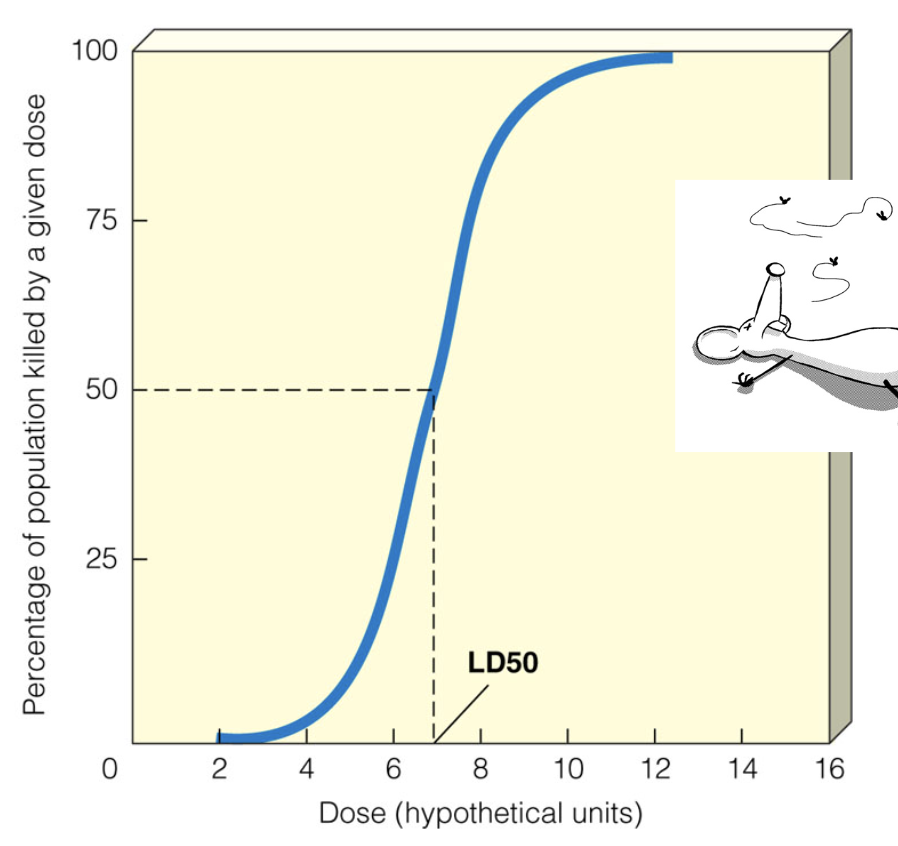
Dose-response curves: No threshold
Any dosage of a toxic chemical/ionizing radiation causes harm that increases with the dosage.
Dose-response curves: Threshold
A threshold dosage must be reached before any detectable harmful effects occur
Presumably because the body can repair the damage caused
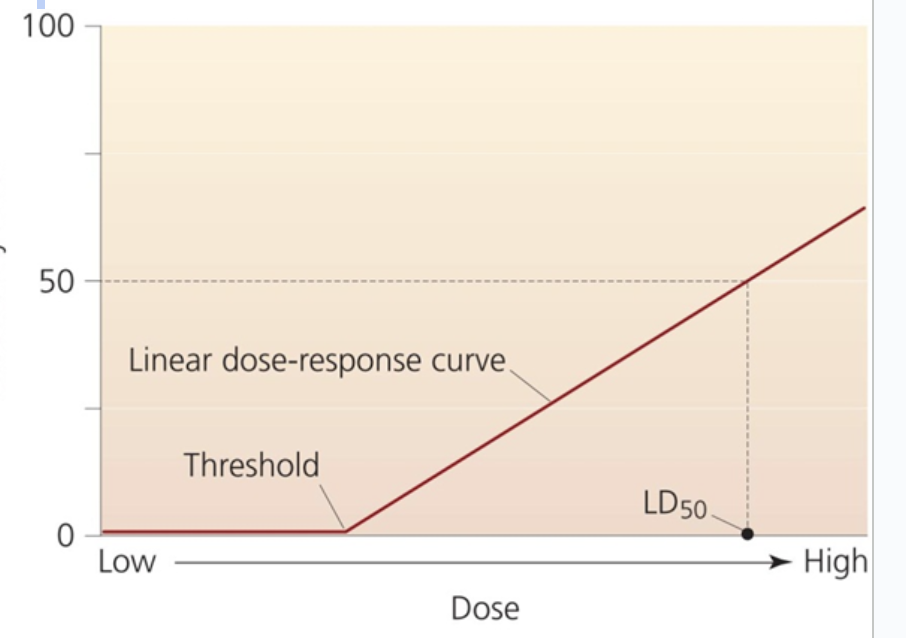
Hormesis
radiation and some toxic substances that can harm or kill us at high doses may have beneficial effects at very low doses
radiation and some toxic substances that can harm or kill us at high doses may have beneficial effects at very low doses.
Botox… poison as cure for nerve damage, chronic pain, cosmetics
Effect of Chemicals on Body Systems
Immune System: Chemicals can substantially decrease system function
Nervous system (brain, spinal cord): Can be affected by natural & synthetic chemicals called neurotoxins
Endocrine system (glands that secrete hormones): Chemicals can turn on or off bodily systems that control sexual reproduction, growth, development, learning ability and behavior
Children & Chemical Exposure
Children are more susceptible to chemicals because their bodies are still developing & acceptable doses for adults are still harmful in children
Dealing with Ecotoxicity
Pollution prevention (input control): Reduces or eliminates the production of pollutants
Pollution clean up (output control): Involves cleaning up or diluting pollutants after they have been produced.
OLD: Dilution paradigm
NEW: Boomerang paradigm
Problems with focusing only on pollution clean up?
Cleanup often removes a pollutant from one part of the environment and moves it to another.
Once pollutants are dispersed into the environment at harmful levels, it usually costs too much to reduce them.
Common diseases transmitted through contaminated drinking water
Bacterial: Typhoid Fever, Cholera, Enteritis, dysentery
Viral: Infection hepatitis
Parasitic Protozoan: Amoebic dysentery, Giardiasis
Parasitic Worm: Guinea worm, Schistosomiasis
Mercury In Our Water
most toxic form of mercury to humans. Bacteria in the water convert elemental mercury into methylmercury
Other Bioaccumulators in water
Lead:
Collects in bones
Carcinogen
damage to the nervous system, kidneys, liver
Sterility
growth inhibition
cognitive developmental delays
detrimental effects in blood
PCB:
in plastics
fire retardant material.
Collects in fatty tissue, muscle & skin
thought to be carcinogen
Plant Nutrients
Primarily fertilizers- contribute to eutrophication
Slow flushing action, increases effects of pollution
Eutrophication vs Cultural Eutrophication
Eutrophication: unnatural enrichment of lakes from runoff of plant nutrients off of surrounding land
Cultural eutrophication: excessive inputs of nutrients (mostly nitrate and phosphates) from human activities like agriculture.
leads to eutrophic conditions, which can cause algal blooms, oxygen depletion
case study

case study
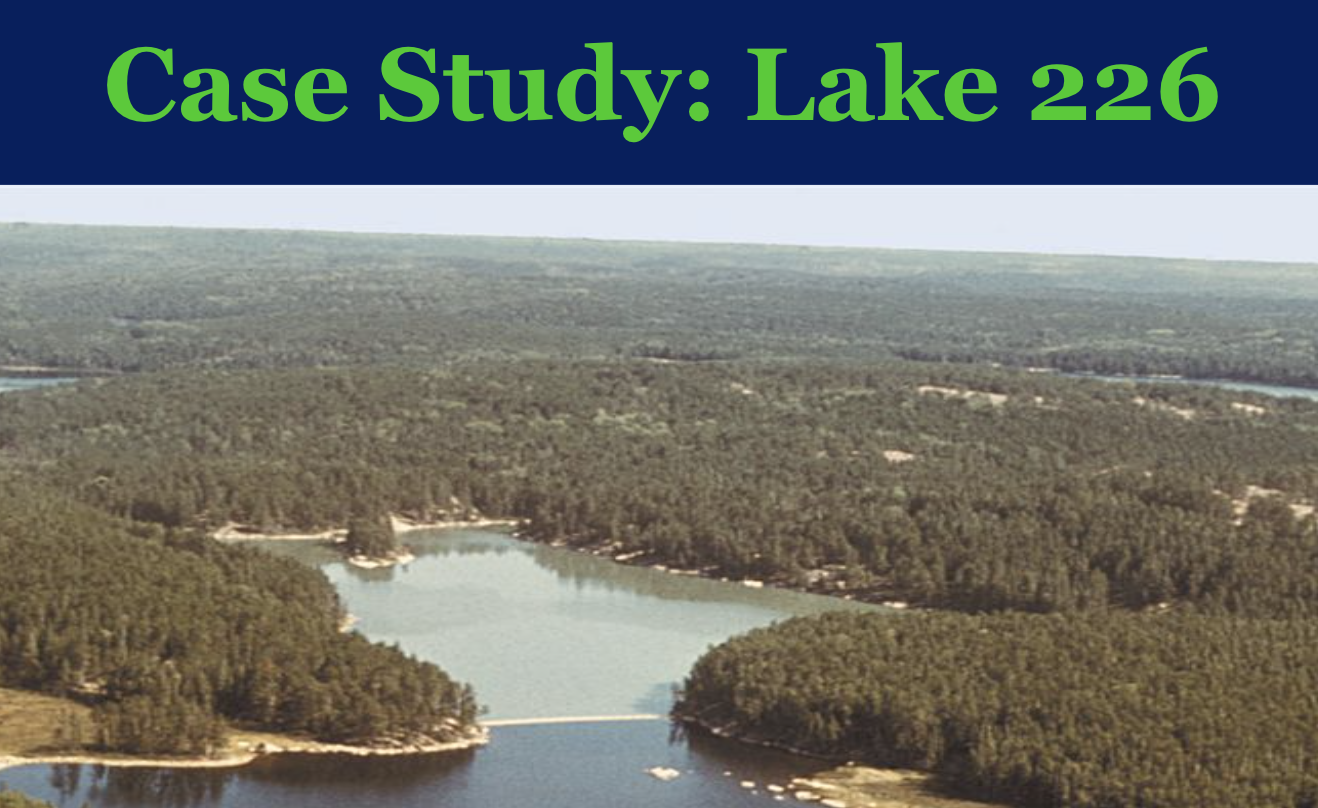
case study

case study
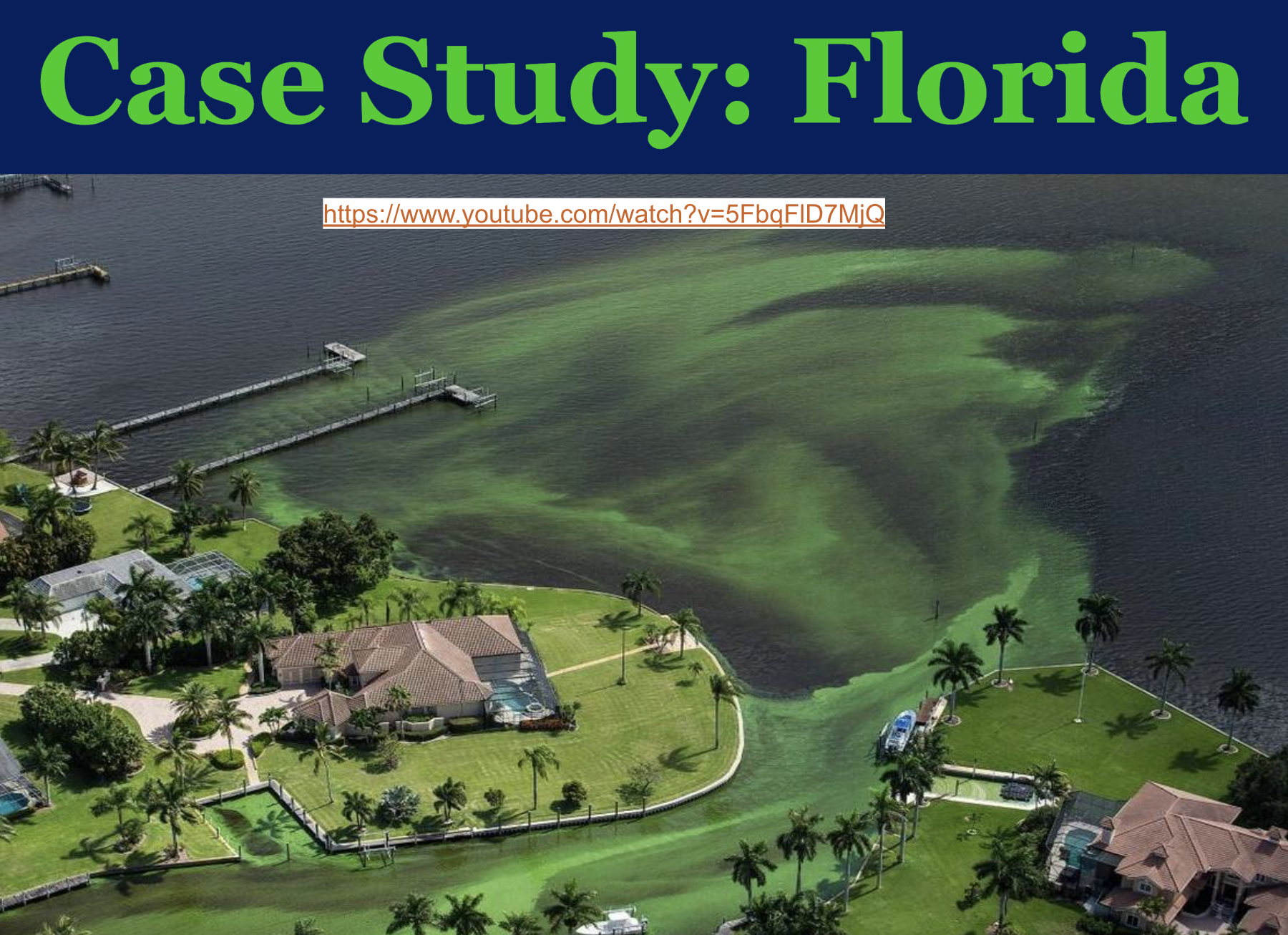
water pollution examples
Sediment:
(#1 cause of water pollution around the world). Can increase the turbidity (cloudiness) of the water, limiting photosynthesis capabilities. Can also decrease the range of visibility for visual predators, leading to a decreased hunting success rate, leading to population declines.
Heat Pollution:
Increasing temps cause gases to dissolve OUT of water. As temps increase, DO decreases, leading to hypoxic zones. Common sources are power plants.
Organic Chemicals
(oil, gasoline)
Oil Spills
Sources: offshore wells, tankers, pipelines and storage tanks
Effects: death of organisms, loss of animal insulation and buoyancy, smothering
Significant economic impacts
Mechanical cleanup methods: skimmers and blotters
Chemical cleanup methods: coagulants and dispersing agents
Major Types of Hazards
Cultural hazards: unsafe working condition, smoking, poor diet, poverty, tanning, drugs, crime
Physical hazards: ionizing radiation, tornado, hurricane
Chemical hazards: from harmful chemicals in the air, water, soil and food
Biological hazards: from pathogens, pollen and allergens
Radon
highly toxic, radioactive gas that is colorless and undetectable
It can build up in basements
Asbestos
mineral that insulates, muffles sounds, and resists fire
Asbestosis = scarred lungs that cease to function
Nontransmissible disease
caused by something other than a living organism and does not spread from one person to another.
Ex. Cancers, diabetes, asthma
Transmissible disease:
caused by a living organism and can spread from one person to another.
Spread by water, air, food, body fluid, insects and other nonhuman carriers or vectors
Ex. Malaria caused by Plasmodium, giardiasis caused by Giardia
Emerging diseases
those diseases which have made a jump from a nonhuman to a human host
Emerging
disease spread
R0: indicator of how quickly that a disease will spread. The subscript is an indicator of how many people an infected person will infect.
R0< 1: the disease is declining and will die out on its own
R0= 1: the disease is stable and won’t cause an epidemic
R0> 1: the disease can lead to an outbreak and/or epidemic
herd immunity
occurs when a large portion of a community (the herd) becomes immune to a disease, making the spread of disease from person to person unlikely
The greater the R0 value, the larger portion of the population that needs to be immune to prevent the spread of the disease
Vaccines help increase herd immunity and with fewer effects that from the spread of the disease itself
recent disease successes
Ebola vaccine
Malaria vaccine
COVID-19 vaccine
The first ebola vaccine to be approved in the United States was rVSV-ZEBOV in December 2019.
1st malaria vaccine approved in Dec. 2021
Factors in growing bacterial antibiotic resistance:
reproductive rate of bacteria
rate of human travel and trade of goods
overuse of pesticides
overuse of antibiotics
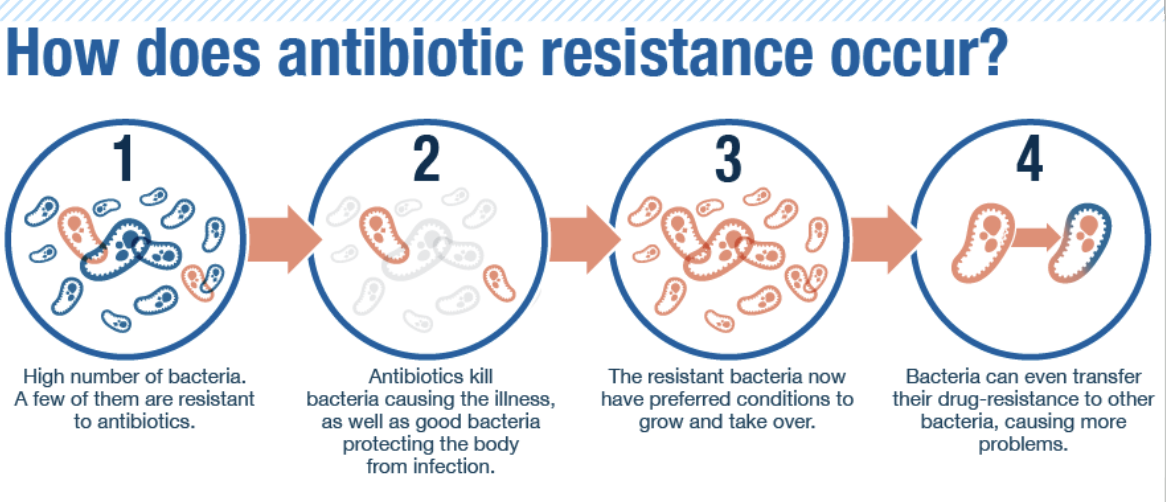
Disease on environmental health
Despite our technology, disease kills most of us
Disease has a genetic and environmental basis
Cancer, heart disease, respiratory disorders
Poverty and poor hygiene foster illnesses
Poverty-stricken, low-income areas often lack sanitary waste disposal and have contaminated drinking water supplies, leading to havens and opportunities for the spread of infectious diseases.
best way to reduce disease?
Improve the basic living conditions of the poor
Food security, sanitation, clean drinking water
Expanded access to health care
Health clinics, immunizations, pre- and postnatal care
Education campaigns work in rich and poor nations
Public service and governments give advice
Packaging and ads advise us on smoking, etc.
Sex and reproductive health education slows population growth and spread of HIV/AIDS
Bioterrorism
Deliberate release of disease causing bacteria or viruses into the air, water supply, or food supply of concentrated urban populations.
Cheap, easy and more effective way to cause illness, death, and mass terror
Governments have used recombinant DNA to produce more dangerous version of these organisms that act faster and are more virulent and resistant to antibiotics.
Ex: Anthrax
Toxicity
measure how harmful a substance is in causing injury, illness or death to a living organism.
depends on several factors:
Dose
Exposure
How well your body detoxifies
Who was exposed
Genetic makeup
What makes a chemical toxic?
1. Solubility
Water soluble: move through environment, through aqueous solutions surrounding cells of our body easily
Fat/oil soluble: can penetrate cell membranes with ease
2. Persistence
resistant to breakdown and do their job for a long time
3. Bioaccumulation
some molecules are absorbed and stored in specific organs or tissues at higher than normal levels.
4. Biomagnification
levels of some potential toxins in the environment are magnified as they pass through food chains and webs.
5. Chemical interactions
Antagonistic
Vitamins A and E interact to reduce body’s response to certain carcinogens
Synergistic
Asbestos alone… 20 fold increase in cancer
Asbestos + smoking ….. 400 fold
Endocrine Disruptors
Hormones stimulate growth, development, sexual maturity
Synthetic chemicals
Block hormones
Mimic hormones
Chemicals like:
Chlorine containing PCBs and dioxins
Heavy metals lead and mercury
Pesticides like DDT
Plastic additives phthalates and bisphenol A
is bisphenol A (BPA) safe?
BPA causes cancer, nerve damage, and miscarriages
In extremely low doses
It is in hundreds of products
Cans, utensils, baby
bottles, laptops, toys
BPA leaches into food,
water, air, and bodies93% of Americans have it in their bodies
Bisphenol A mimics estrogen
In lower levels than set by regulatory agencies
Researchers, doctors, and consumer advocates want regulation
The chemical industry insists it is safe
Some countries and states have banned it
Many companies are removing it voluntarily
Secondary Recycling
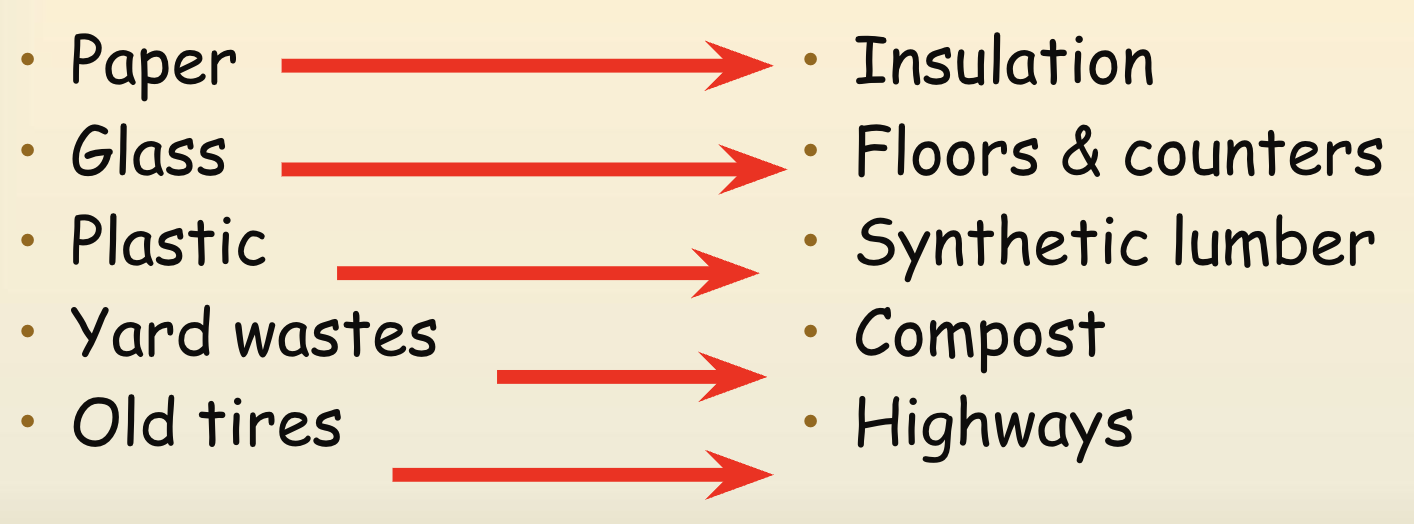
Recycling aluminum
decrease 95% air pollution
decrease 95% mining energy (from rain forest bauxite)
decrease 97% water pollution
2018…35% being recycled in U.S. (decreasing amount ☹)
Recycling PAPER
New production takes tons of trees and chlorine
Recycling paper
US ~ 68%
Saves energy
Decreases air pollution
Decreases water pollution
Tires
Take up lots of landfill space
Won’t break down
reuse-retread, use to line landfills, soaker hoses, asphalt
Fire hazard
Collect water & become mosquito breeding grounds
Most states either ban tires in landfills or require them to be shredded
Recycling Plastics - Difficult
Chemically stable & don’t readily break down
More than ½ from packaging
Only 6% recycled in US in 2021
(PETE {PolyEthylene Terephthalate} best)
Price of new < recycled
Produces hazardous wastes - Cd & Pb leach out into groundwater
Nondegradable 400+ years
Burying Waste
Good
No open burning Low groundwater pollution
Built quickly
Handle large amts
Recycled into parks
Bad
Noise & traffic
Release GH gases like methane
Slow decomp
Discourages recycling & waste reduction
Waste Incineration
Pros
Reduces volume of solid waste in landfills (ash more compact)
Produces heat which can make steam to warm buildings or generate electricity.
Cons
Add CO, particulates & heavy metals to air
Produces bottom ash Produces fly ash (trapped by pollution control devices-contains toxic materials)
Both types of ash are hazardous waste.
What to Burn
Paper = best
Burns readily and has high amt of heat content.
Glass
Doesn’t burn
melted glass difficult to remove from incinerator
Plastic
produces a lot of heat
released pollutants are a concern.
Tires
produce as much heat as coal, but produce lots of hazardous air pollutants
Mass burn incinerators
mixed trash dumped into a huge furnace & burned.
Increases air pollution, especially dioxins
Increasing in US
Refuse derived fuel incinerators
separate burnable waste from unburnable & recyclable materials
Much less hazardous air pollution
Composting Yard Waste
This can save 13% of the solid waste going into landfills.
Easiest way - mulching mower
Holds water
reducing erosion and water use
Source of nitrogen - feeds the lawn
Factors Contributing to Increasing Amounts of Municipal Solid Waste (MSW)
Increasing populations
Changing lifestyles
Disposable materials*
Excessive packaging*
5 Ways to Reduce Resource Use
1. Consume less
2. Redesign manufacturing to decrease pollution & waste
3. Develop easy to repair, reusable products
4. Develop long lasting products
5. Eliminate unnecessary packaging
Reuse—Clean & Use Again
Reduces energy waste and pollution MORE THAN RECYCLING
Ex. Salvage automobiles parts, utensils, plates, handkerchiefs, cloth grocery bags
1960’s- 90% soft drinks, 50% beer sold in refillable glass bottles
now only 10% refillable (glass)
cheaper to produce
recycling Primary (closed loop)
closed loop)
new product of same type
old alum. cans 🡪 new alum. cans
Saves up to 95% of the materials & energy
recycling secondary (open loop)
Secondary (open loop)
Different product (lower quality)
Saves 25% max.
Plastic bottle 🡪 carpet
Hazardous Waste
Any discarded solid or liquid that is:
Toxic
Damaging if inhaled, ingested or even touched in some cases
carcinogenic, teratogenic compounds
Ignitable
likely to catch fire
Gas, paints
Corrosive
can cause damages to surfaces upon contact
bleach, acids, bases
Reactive
Capable of being explosive or releasing toxic fumes
Nitroglycerin, chlorine bleach, ammonia
Hazardous waste Solutions?
Produce less
Detoxify physically ex. Filtering, chemical rxns to less harmful substance
Special storage (glass, cement)
Bioremediation (using life)
Phytoremediation (using plants)
Rhizofiltration
Phytostabilization
Phytodegradation
Phytoextraction
Other Hazardous Material Disposal Ideas…
Deep underground wells
Liquid hazardous wastes are pumped under pressure through a pipe into dry, porous geologic formation of rock far beneath aquifers tapped for drinking.
Surface Impoundments
Excavated depressions like ponds & lagoons into which liquid hazardous wastes are drained and stored.
Case Studies: Lead
Lead poisoning major problem in children’s development, accumulates in bones
Primary Sources of Lead
Leaded gasoline (phased out by 1996)
Lead paint (banned in 1970)
Lead in plumbing that is leached out
Mercury
Fish contaminated with methylmercury
Natural inputs
Emission control
Burning coal (& waste)
CFL light bulbs contain mercury---if thrown away broken or crushed at landfill, this can leach into soil or water sources.
Biomagnified
Neurological problems
Dioxins
Potentially highly toxic chlorinated hydrocarbons
known to cause cancer, disrupt the immune system and cause reproductive harm
bioaccumulation
They are an unintentional side effect of combustion
Sources
Waste incineration
Fireplaces
Coal-fired power plants
Paper production
Sewage sludge
PCB’s
Contain carbon, hydrogen and chlorine
Used as cooling fluids, hydraulic fluid, fire retardants, lubricants, old plastics, adhesives—Banned ’77
Harms eyes, skin, reproductive organs & GI system
Endocrine disruptor, interferes with thyroid gland.
Biomagnify & highly persistent
Haz. Waste Regulation in US
1976- RCRA (Resource Conservation and Recovery Act)
3 Goals:
EPA IDs haz. Wastes & sets management standards
Must have permit to store, treat or dispose of more than 220 pounds of haz. waste per month
Permit holders must use a cradle to grave system.
Must have a permit to produce it
responsible for following the product from birth, use, till death.
CERCLA & Superfund
Comprehensive Environmental Response, Compensation & Liability Act
Taxes chemical raw materials which provides a trust fund to achieve 3 goals.
Fund is called the Superfund
Goals of CERCLA
ID abandoned haz. waste dump sites
Protect & clean up groundwater near sites
Clean up sites. Responsible parties must pay for cleanup (if they can be found) or govt. will clean up using Superfund.
Put worst sites on Priority list
Industries Emitting Largest Amounts of Toxic Air Pollutants
Mining
Electric Utilities
Chemical Production
Primary metal production
5 States with Most Superfund Sites
New Jersey (152)
Pennsylvania (127)
New York (122)
California (114)
Florida (92)
Santa Clara County, CA (AKA Silicon Valley has more sites (23) than any other county.
Reusing Dangerous Sites
Brownfields: abandoned industrial and commercial sites contaminated with haz. Waste.
cleaned up
turned into…
Parks
nature reserves
athletic fields
neighborhoods
after toxic material is removed from soil & groundwater.
International-
POP Treaty
Uses precautionary principle
By 2020, no more POP… fought heavily by US industry
Limits hazardous waste exports
Control 12 “persistent organic pollutants” (POPs) – they biomagnify
DDT, Cl- pesticides, PCB’s, furans & dioxins
POPs are fat soluble (can bioaccumulate) and can travel long distances via wind/ water
3 Major Sources of Water Pollution
Agricultural activities
Leading cause
Eroded sediment from overgrazing, pesticides, fertilizers
Industrial facilities
Power plants
Textiles
Improper waste disposal
Mining
Acid drainage
Chemical runoff
Point sources
discharge pollutants at specific location through drain pipers, ditches or sewer lines into bodies of water.
Nonpoint sources
scattered and diffuse and cannot be traced to any single site of discharge
Stream Pollution: Better or Worse?
In Developed Countries:
Point source pollution has decreased, but non point sources are still a problem
In Developing countries:
Untreated sewage and industrial waste is a growing problem
Why? They cannot afford to build water treatment plants
water pollution monitoring
Counting colonies of fecal coliform bacteria
2 billion excreted per person per day…yum!
Drinking water should have NO colonies
Level of dissolved oxygen
Biological oxygen demand (BOD)
Chemical analysis
Monitoring indicator species
Sewage Treatment:
Primary Sewage Treatment
Physical Process
Uses screens and a grit tank
Removes 60% of suspended solids
Removes 30-40% of O2 Demanding organic wastes
Removes 0% NO, PO, salts, isotopes, pesticides
Sewage Treatment:
Secondary Sewage Treatment
Biological process
Uses aerobic bacteria
Removes 90% of dissolved biodegradable O2 Demanding wastes
Sewage Treatment:
Combined: Primary and Secondary
95-97% of suspended solids and O2 Demanding wastes
70% of toxic metal compounds and non-persistent synthetic organics
50% of Nitrogen
5% of salts
Only a fraction of isotopes and persistent organics
Physical and biological treatment
Clean Water Act
Most cities combine primary and secondary
However 2/3 of plants have violations
500 cities have failed to meet federal standards
Many still simply screen and flush
Federal Water Pollution Control Act 1972 (amended 1977)
Water Quality Act in 1987
Sets standards for allowed levels of key water pollutants
Requires polluters to obtain permits for discharge into water sources
EPA Discharge trading policy
Water pollution credits? (EPA similar to carbon credits)
Technological Approach:
Advanced (Tertiary) Sewage Treatment
Removes nitrate and phosphate
Not widely used (expense)
treats only 5% of all waste water
bleaching and disinfection after primary and secondary
Chlorination often used
Ozone and UV effective
more expensive
Lasts a shorter period of time
Drinking Water Quality
Polluted drinking water is considered a
HIGH HEALTH RISK
Purification of urban drinking water
Protection from terrorism
Purification of drinking water in poor populations
Safe Drinking Water Act
Maximum contaminant levels (MCLs)
Bottled water?
240-10,000 x more expensive than tap
25% of bottles is tap water
1.4 million metric tons of bottles/year
Manufacturing waste of bottling
Water bottle waste
Non point pollution
Microplastics found in 90% of water bottle samples
Solutions: Preventing and Reducing Surface Water Pollution
Nonpoint Sources
Reduce runoff
Buffer zone vegetation
Reduce soil erosion
Point Sources
Clean Water Act
Water Quality Act